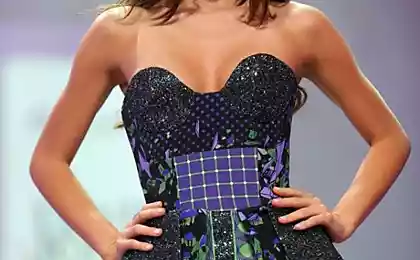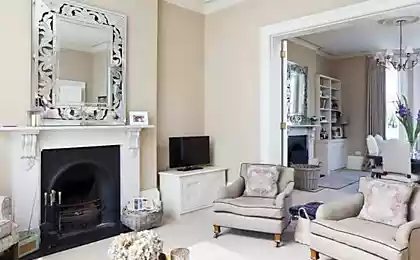226
Who and why invented strange drawings on carpets from the Land of Soviets
We all remember. Soviet carpets with strange patterns. On the floor or on the wall, they were in every house. The trend of that time appeared for a reason. What hide these items "luxuries" - we will talk in this article.
Carpets in the Union were used for a reason. First, they replaced wallpaper, which at the time was difficult to find. Secondly, they were hung on the walls for thermal insulation. Most often the carpet closed the wall near the bed. It was also used to isolate noise in Khrushchev apartments.
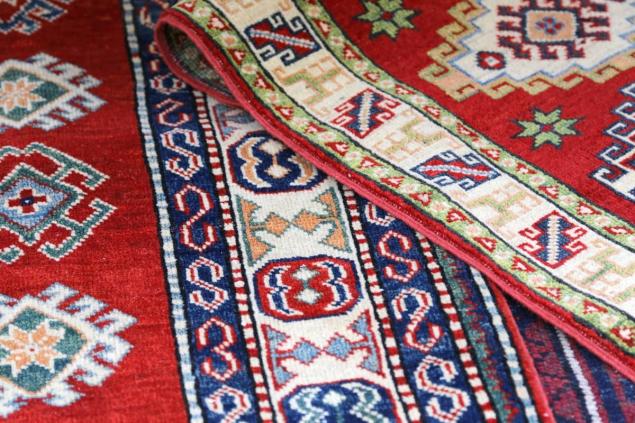
In Soviet times, it was considered prestigious to have several imported luxury carpets. They were supplied mainly from Turkmenistan, Azerbaijan and Georgia. A good carpet was considered a symbol of prosperity and well-being of the family. Most likely, the Soviet people borrowed the tradition from the Eastern peoples.
As a child, we studied the ornaments of such carpets. Fantasizing, inventing anything. But no one thought: what do patterns really mean? Could it be some secret messages? Or is it just folklore? It's time to know the truth.

It turns out that in the USSR, the Catalog of Vneshposyltorg was published, in which models for order were presented. It was possible to order from the Soviet republics and even from abroad. In the catalog, in addition to the name of the product, there were brief descriptions of the ornaments.
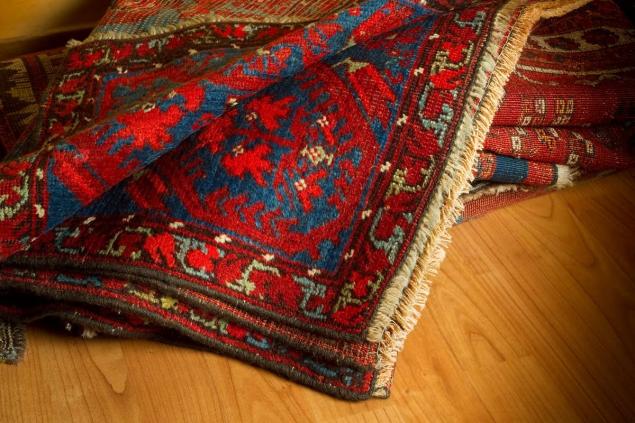
For example, from Azerbaijan it was possible to order carpets "Kazakh", "Arabakh" and for some reason "Cuba". Ordinary people did not have access to the catalog - they bought carpets from dealers. Consequently, they did not know what the images on the carpets meant.
On Armenian carpets “Yerevan” and “Ijevan” you can see folk miniatures. The main motif is a lotus flower depicting flowers, stems and petals. This pattern symbolized wealth and a generous harvest. In addition, the lotus is a symbol of perfection, which expresses fertility, peace and tranquility.

Turkmen carpets were decorated with diamonds called “gel”. Rhombus is the source of life and satiety. It's a symbol of strength and security. Rhombus was often a medallion of Turkmen carpets.
The medallion is the heart, the very center of the carpet. It is depicted as an oval, circle or rhombus. It is embroidered as a composition of flowers or stems and is associated with the disk of the sun.
All carpet drawings were traditional. That is, they were not invented by Soviet people. But they took as a basis the folk traditions of the Soviet republics.
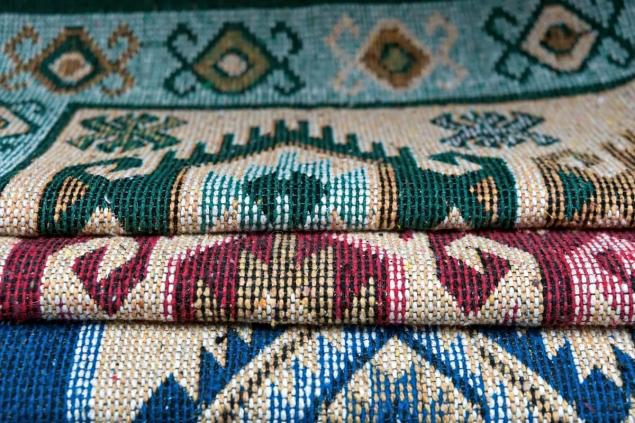
Classification of carpet patterns can be divided into 3 groups: plants, animals and geometric figures. Most elements play the role of talismans that can bring prosperity to the house.
Avshan - in translation means "strewn". This is a repetitive pattern of the plant world, without a medallion. The pattern of Heshti is the same, only executed in chess order. Plants on the ornament represent fertility and prosperity. They are depicted in the form of flowers, stems or arrows. Sometimes on carpets you can find a vase with flowers - a symbol of sublime love.
If you try, you can see the animals. For example, sheep and sheep are depicted in the shape of the English letter “S”. It is a memory of the nomadic way of life of the Eastern peoples. In rare cases, an eagle or rooster can be found as symbols of royal power and rebirth.
Geometric shapes on carpets also depict nature, but only schematically. Less commonly, they are used as signs with a special meaning, such as a medallion pattern. Often among the figures you can find lines twisted in a spiral. This is Eslim, the symbol of infinity.

Everyone can see in the patterns something of their own. On a subconscious level, we read the signs of our ancestors and supplement them with our stories. Perhaps this is the true meaning of traditional patterns. By the way, carpet fashion is back again. If you correctly fit the “rarity” into the interior, it will look beautiful and original.
A few tips

The wall carpet can decorate any, even the most strict interior. Before its warm texture, neither loft nor the most fashionable high-tech will resist. It will bring comfort, care and nostalgia to the house for the past century. Try, experiment - maybe an old rug from the nineties will be the highlight of the design of your apartment. Good luck!
Carpets in the Union were used for a reason. First, they replaced wallpaper, which at the time was difficult to find. Secondly, they were hung on the walls for thermal insulation. Most often the carpet closed the wall near the bed. It was also used to isolate noise in Khrushchev apartments.

In Soviet times, it was considered prestigious to have several imported luxury carpets. They were supplied mainly from Turkmenistan, Azerbaijan and Georgia. A good carpet was considered a symbol of prosperity and well-being of the family. Most likely, the Soviet people borrowed the tradition from the Eastern peoples.
As a child, we studied the ornaments of such carpets. Fantasizing, inventing anything. But no one thought: what do patterns really mean? Could it be some secret messages? Or is it just folklore? It's time to know the truth.

It turns out that in the USSR, the Catalog of Vneshposyltorg was published, in which models for order were presented. It was possible to order from the Soviet republics and even from abroad. In the catalog, in addition to the name of the product, there were brief descriptions of the ornaments.

For example, from Azerbaijan it was possible to order carpets "Kazakh", "Arabakh" and for some reason "Cuba". Ordinary people did not have access to the catalog - they bought carpets from dealers. Consequently, they did not know what the images on the carpets meant.
On Armenian carpets “Yerevan” and “Ijevan” you can see folk miniatures. The main motif is a lotus flower depicting flowers, stems and petals. This pattern symbolized wealth and a generous harvest. In addition, the lotus is a symbol of perfection, which expresses fertility, peace and tranquility.

Turkmen carpets were decorated with diamonds called “gel”. Rhombus is the source of life and satiety. It's a symbol of strength and security. Rhombus was often a medallion of Turkmen carpets.
The medallion is the heart, the very center of the carpet. It is depicted as an oval, circle or rhombus. It is embroidered as a composition of flowers or stems and is associated with the disk of the sun.
All carpet drawings were traditional. That is, they were not invented by Soviet people. But they took as a basis the folk traditions of the Soviet republics.

Classification of carpet patterns can be divided into 3 groups: plants, animals and geometric figures. Most elements play the role of talismans that can bring prosperity to the house.
Avshan - in translation means "strewn". This is a repetitive pattern of the plant world, without a medallion. The pattern of Heshti is the same, only executed in chess order. Plants on the ornament represent fertility and prosperity. They are depicted in the form of flowers, stems or arrows. Sometimes on carpets you can find a vase with flowers - a symbol of sublime love.
If you try, you can see the animals. For example, sheep and sheep are depicted in the shape of the English letter “S”. It is a memory of the nomadic way of life of the Eastern peoples. In rare cases, an eagle or rooster can be found as symbols of royal power and rebirth.
Geometric shapes on carpets also depict nature, but only schematically. Less commonly, they are used as signs with a special meaning, such as a medallion pattern. Often among the figures you can find lines twisted in a spiral. This is Eslim, the symbol of infinity.

Everyone can see in the patterns something of their own. On a subconscious level, we read the signs of our ancestors and supplement them with our stories. Perhaps this is the true meaning of traditional patterns. By the way, carpet fashion is back again. If you correctly fit the “rarity” into the interior, it will look beautiful and original.
A few tips
- The lines of the carpet and its ornament should echo the general lines of the interior of the room.
- It is better to choose neutral colors and monochrome combinations. So the carpet will stand out less and catch your eye.
- We recommend using a carpet to allocate only one area. For example, above the head of the bed or behind the work chair. Thus, the carpet will not “eat” extra space, but will connect furniture and walls into a single composition.

The wall carpet can decorate any, even the most strict interior. Before its warm texture, neither loft nor the most fashionable high-tech will resist. It will bring comfort, care and nostalgia to the house for the past century. Try, experiment - maybe an old rug from the nineties will be the highlight of the design of your apartment. Good luck!
Why you should eat a piece of fat a day is mandatory
How to easily spoil the okroshka and how to cook it according to all the rules






